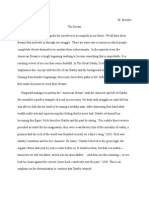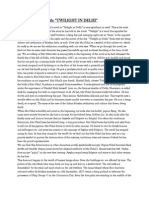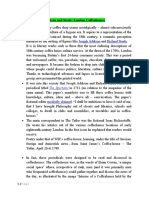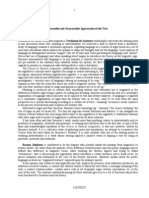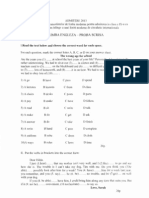0 ratings0% found this document useful (0 votes)
904 viewsT.S. Eliot's Genre, Writing Style, Issues and Their Relevance Today
T.S. Eliot's Genre, Writing Style, Issues and Their Relevance Today
Uploaded by
Ana-Maria AlexandruT.S. Eliot was a pioneer of modernist poetry in the early 20th century. He introduced a new style using both common speech and obscure allusions that were difficult for most readers to understand. Eliot wrote about themes of death, loss, and spiritual recovery through poems like "The Waste Land" that explored his difficult first marriage and the post-war attitudes of the time. His highly allusive works required research and analysis to fully comprehend, and his unique style incorporated influences from a wide range of literature to create new layered meanings in his concise yet complex poems.
Copyright:
© All Rights Reserved
Available Formats
Download as DOCX, PDF, TXT or read online from Scribd
T.S. Eliot's Genre, Writing Style, Issues and Their Relevance Today
T.S. Eliot's Genre, Writing Style, Issues and Their Relevance Today
Uploaded by
Ana-Maria Alexandru0 ratings0% found this document useful (0 votes)
904 views2 pagesT.S. Eliot was a pioneer of modernist poetry in the early 20th century. He introduced a new style using both common speech and obscure allusions that were difficult for most readers to understand. Eliot wrote about themes of death, loss, and spiritual recovery through poems like "The Waste Land" that explored his difficult first marriage and the post-war attitudes of the time. His highly allusive works required research and analysis to fully comprehend, and his unique style incorporated influences from a wide range of literature to create new layered meanings in his concise yet complex poems.
Original Description:
T
Original Title
T
Copyright
© © All Rights Reserved
Available Formats
DOCX, PDF, TXT or read online from Scribd
Share this document
Did you find this document useful?
Is this content inappropriate?
T.S. Eliot was a pioneer of modernist poetry in the early 20th century. He introduced a new style using both common speech and obscure allusions that were difficult for most readers to understand. Eliot wrote about themes of death, loss, and spiritual recovery through poems like "The Waste Land" that explored his difficult first marriage and the post-war attitudes of the time. His highly allusive works required research and analysis to fully comprehend, and his unique style incorporated influences from a wide range of literature to create new layered meanings in his concise yet complex poems.
Copyright:
© All Rights Reserved
Available Formats
Download as DOCX, PDF, TXT or read online from Scribd
Download as docx, pdf, or txt
0 ratings0% found this document useful (0 votes)
904 views2 pagesT.S. Eliot's Genre, Writing Style, Issues and Their Relevance Today
T.S. Eliot's Genre, Writing Style, Issues and Their Relevance Today
Uploaded by
Ana-Maria AlexandruT.S. Eliot was a pioneer of modernist poetry in the early 20th century. He introduced a new style using both common speech and obscure allusions that were difficult for most readers to understand. Eliot wrote about themes of death, loss, and spiritual recovery through poems like "The Waste Land" that explored his difficult first marriage and the post-war attitudes of the time. His highly allusive works required research and analysis to fully comprehend, and his unique style incorporated influences from a wide range of literature to create new layered meanings in his concise yet complex poems.
Copyright:
© All Rights Reserved
Available Formats
Download as DOCX, PDF, TXT or read online from Scribd
Download as docx, pdf, or txt
You are on page 1of 2
T.S.
Eliot's Genre, Writing Style, Issues and Their Relevance Today
World War I brought about a revolution in the art of poetry. T.S. Eliot was one of the Initiators of the
modernist revolution. Writing mostly poetry and plays, he introduced a new style of writing utilizing both
common speech of the time and very obscure allusions. Eliot was a pioneer of the modernist revolution, using
obscue allusions which were hard for the common people to follow. (Through his difficult first marriage, he
was able to fuel some of his powerful writings, such as "The Waste Land." His works involved a complicated
style, allusions being the common element. He wrote about things that concerned him, specifically having to do
with the post-war attitudes many people had. He wrote about death, loss, and spiritual recovery which for the
most part are still of concern today.)
Eliot was born Thomas Stearns Eliot in St. Louis, Missouri on September 26, 1888. His parents were
Henry Ware Eliot, a businessman, and his wife Charlotte Chauncey Stearns, a poet. He was well educated,
attending Harvard, the Sorbonne at Oxford, and Merton College. He entered Harvard in 1906, and studied
philosophy in graduate school. He also became editor of The Harvard Associate. He went on to study French at
the Sorbonne, then back to Harvard to study metaphysics, logic,philosophy, psychology, and Sanskrit. He also
studied Greek philosophy and German at Merton. He went on to teach at Highgate near London where he taught
French, Latin, lower math, drawing, swimming, geography, history, and baseball. Once again he returned to
Harvard this time to teach, along with many other teaching jobs. Then he became a banker, registered for the
U.S. Navy, then became director for The Egoist. In 1915, he married Vivienne Haigh-Wood. 1922 brought "The
Waste Land," his most famous poem, which is believed to have been the story of his marriage to Vivienne. He
became editor for The Criterion, where he introduced the works of W. H. Auden in 1923. He was fascinated
with the English culture, especially the dark side of their upper middle class. He wanted to leave his American
past behind him, and thus he became a legal subject of England and converted to the Anglican Church. In 1938
his marriage to Vivienne ended tragically, when he sent her to a mental hospital for 9 years. She died there, not
having seen or spoken to Eliot in 12 years. He re-married 19 years later to Valerie Fletcher, who was his private
secretary. Throughout his life, his writings received many awards such as the Nobel Prize, the Hanseatic Goethe
Prize, and the U.S. Presidential Medal of Freedom.
Eliot had a very unique style. He was a very knowledgeable man who knew much of literature. His
writing style involved many allusions which were hard for the average man to follow. This kept his popularity
at the beginning of his writing career to be low. To fully understand and appreciate his poetry, one must do
research or have footnotes, for he uses obscure allusions. In this, he educates and makes people work and think
to understand his complicated works, which were commonplace to him. His use of allusion allows him to
capture feeling through the previous works, making his works concise and simple, yet so complicated and deep
as to discourage the reader. The problem with his voice was it being above the understanding of his readers.
When one analyzes his work, one can see how intricate they are. The only way to fully understand his works is
to analyze them thoroughly.
"The Hollow Men" uses many allusions; from The Lord's Prayer, to The Heart of Darkness by Joseph
Conrad, to the English customs of Guy Fawkes Day. Guy Fawkes Day, on November 5, commemorates
stopping Guy Fawkes and his cohort's attempts to blow up both Houses of Parliament. It can be difficult for the
reader to discover such things as these and then the meaning still must be deciphered. He begins the poem with
an allusion to The Heart of Darkness speaking of Kurtz, a trader with no strengths and thus he becomes barbaric
in the central African jungle. He later refers to Kurtz as a violent soul, which is opposite of the hollow men. The
hollow men refer to all people. People have a lack of spiritual passion. They have no motivation, towards good
or evil, as Kurtz is a man who becomes rash and commits great acts of evil. This brings the reader, once he
understands the opening, to be intrigued as to how this relates to hollow men.
While Eliot has concise sentences, they aren't that clear. This is because of the complexity of his works.
While his grammar is smooth, the messages are often over the reader's head. This being attributed to his
allusions and them having their own meaning. All of the allusions wrapped together produce a whole new
meaning, which is the wonder of his work. Through his intervention and usage of allusions, he is able to contort
all of them put together into a new message, usually completely different than the references.
Brevity is a problem he has. While it is for emphasis, he is very repetitive, sometimes repeating the same
line over and over, consecutively or sometimes restates them multiple times. In doing this, he is able to stir
images in the reader's head. Using new wording for a similar line invokes further images. He is able to reveal
emotions by invoking them in us, rather than bluntly stating them.
Through his allusions, he gives fresh comparisons. Rather than using plain comparisons, he compares
his ideas with those presented in previous works by other authors. This, once the other work is understood,
sheds great light on his point. His comparisons are almost always new to the ear, thus appealing and intriguing.
If one can take the time to understand the allusion it keeps their attention almost glued to the words. On the
other hand, this can also thwart one from continuing reading or at least finding out the meaning because of the
time and effort involved. His poems have so much to say which can regrettably be lost in one's lack of
knowledge of literature.
Another aspect, both appealing to the eye, ear, and mind is his sentence usage and placement. In his
poems, he will have strangely placed sentences on a line, choppy sentences that continue on the next line with
strange breaks, and their lengths are not uniform. This can seem strange, especially to the non-enthusiast, but
provides differentiation to normal, uniform poems. This uniqueness makes for interesting poems.
Eliot always put flair in his poems. He knew so much of literature and also researched it, looking for the
right piece to illustrate his point. This gives the reader a chance to explore the entire poem. A reader can see the
time put into his poems simply through this, and the reader also has to put time into understanding them.
In the end of his works, he takes everything from the work and wraps it up in a simple statement. This
makes it beautiful, and once understood slightly, incredibly easy to fully grasp. While some writers pull some
things together from their work, he is able to, in some way, bring it all together. This is a feat not easily done, as
it can be hard to relate so many things, especially as complicated and deep as Eliot makes them. Being able to
utilize so many sources in his works and his language and sentence usage gives him a one-of-a-kind style, not
matched by many others.
You might also like
- Gatsby Essay (American Dream)Document3 pagesGatsby Essay (American Dream)MiguelNo ratings yet
- Roland Barthes MythologiesDocument6 pagesRoland Barthes Mythologiessarfraz ahmadNo ratings yet
- Reference (I) Poem: Casting and Gathering (Ii) Poet: Seamus Heaney ContextDocument2 pagesReference (I) Poem: Casting and Gathering (Ii) Poet: Seamus Heaney ContextAisha KhanNo ratings yet
- ModernismDocument8 pagesModernismMariangela RizzoNo ratings yet
- Dan Shen Unreliability The Living Handbook of NarratologyDocument10 pagesDan Shen Unreliability The Living Handbook of NarratologyAnonymous uD8YEGVNo ratings yet
- Eliot Views On Metaphysical PoetryDocument6 pagesEliot Views On Metaphysical PoetrySabeeqa MalikNo ratings yet
- Mohsin Hamid - TodayDocument10 pagesMohsin Hamid - TodayAfia FaheemNo ratings yet
- Kurtz and Marlow: Department of English National University of Modern Languages IslamabadDocument5 pagesKurtz and Marlow: Department of English National University of Modern Languages Islamabadsafder aliNo ratings yet
- Modern DramaDocument2 pagesModern DramaAfia FaheemNo ratings yet
- Going, Going 1Document8 pagesGoing, Going 1English Literature StudyNo ratings yet
- Stream of Consciousness in The NovelDocument7 pagesStream of Consciousness in The NovelCELL IELTSNo ratings yet
- Russian FormalismDocument12 pagesRussian FormalismKyla Yumie AbangNo ratings yet
- Philip Larkin Is One of BritainDocument7 pagesPhilip Larkin Is One of Britainchandravinita100% (1)
- Representation of NoseDocument2 pagesRepresentation of NoseJahanzaib Dildar100% (1)
- Salient Features of Modern PoetryDocument3 pagesSalient Features of Modern PoetryAmber Umair81% (16)
- Critical Appreciation or The PainterDocument14 pagesCritical Appreciation or The Paintermanazar hussainNo ratings yet
- English Poetry Between The Two WarsDocument5 pagesEnglish Poetry Between The Two WarsTANBIR RAHAMANNo ratings yet
- Pre-Raphaelite Poetry: DR - Pem Prakash Pankaj Asst - Professor, English Dept Vanijya Mahavidyalaya, PU Mob-8210481859Document8 pagesPre-Raphaelite Poetry: DR - Pem Prakash Pankaj Asst - Professor, English Dept Vanijya Mahavidyalaya, PU Mob-8210481859Sandip KunduNo ratings yet
- Expressivity: The Romantic Theory of AuthorshipDocument10 pagesExpressivity: The Romantic Theory of Authorshiphalaswalihabinthalameen100% (1)
- ENGLISH HISTORY (Romantic Age) - 1Document4 pagesENGLISH HISTORY (Romantic Age) - 1Bhumit ChudasamaNo ratings yet
- Church Going by Philip Larkin - Poem AnalysisDocument21 pagesChurch Going by Philip Larkin - Poem Analysisworld UNONo ratings yet
- Critical Analysis of LondonDocument22 pagesCritical Analysis of LondonCande GamenNo ratings yet
- Bernard Shaw: AS AN IconoclastDocument55 pagesBernard Shaw: AS AN IconoclastMukaberNo ratings yet
- Significance of TitleDocument2 pagesSignificance of Titlejazib1200100% (1)
- Evaluate Tennyson, Browning and Mathew Arnold As The Representative Poets of The Victorian AgeDocument3 pagesEvaluate Tennyson, Browning and Mathew Arnold As The Representative Poets of The Victorian AgePriyanka DasNo ratings yet
- The Wasteland by T.S Eliot: The Burial of The DeadDocument20 pagesThe Wasteland by T.S Eliot: The Burial of The DeadsaifNo ratings yet
- Man and Superman Character ListDocument5 pagesMan and Superman Character Listfahmi tamannaNo ratings yet
- Thomas Beckett Historical Figure and CharacterDocument11 pagesThomas Beckett Historical Figure and Charactersreepmohan100% (1)
- MERUDocument11 pagesMERUrathodvruti83No ratings yet
- As A DramatistDocument3 pagesAs A DramatistAhmed Elashkar100% (1)
- Dante PresentationDocument32 pagesDante PresentationFirdous KhanNo ratings yet
- Females in Heart of DarknessDocument3 pagesFemales in Heart of DarknessNaveen Trivedi100% (1)
- Trends in Modern 20th Century Poetry - Learn English, IELTS, EFL, ESL Public Speaking, Grammar, Literature, Linguistics by NEODocument4 pagesTrends in Modern 20th Century Poetry - Learn English, IELTS, EFL, ESL Public Speaking, Grammar, Literature, Linguistics by NEOAmit Arora0% (1)
- Aspects of Modernism in The NovelDocument4 pagesAspects of Modernism in The NovelFariha KarimNo ratings yet
- Chapter - Ii Satire in Arms and The Man and Its Translation: An EvaluationDocument50 pagesChapter - Ii Satire in Arms and The Man and Its Translation: An Evaluationchurni bhattacharyyaNo ratings yet
- Matthew ArnoldDocument15 pagesMatthew ArnoldgopalNo ratings yet
- Twilight in DehliDocument2 pagesTwilight in DehliNimra Anwar50% (2)
- 20th Century Novel - Notes-2Document25 pages20th Century Novel - Notes-2Najib نجيبNo ratings yet
- The Arrival of The Bee Box: Critical AnalysisDocument3 pagesThe Arrival of The Bee Box: Critical AnalysisnoorNo ratings yet
- Mr. BleanyDocument7 pagesMr. Bleanymubashir gulzar100% (1)
- Shakespear As A SonneterDocument5 pagesShakespear As A SonneterJauhar Jauharabad33% (3)
- Themes in WattDocument3 pagesThemes in WattAwais TareqNo ratings yet
- Drama As A Dominant Form in The Elizabethan AgeDocument9 pagesDrama As A Dominant Form in The Elizabethan AgeTaibur Rahaman100% (1)
- EASTER, 1916: William Butler YeatsDocument13 pagesEASTER, 1916: William Butler YeatsHB 1926100% (2)
- Alexander Pope As A PoetDocument2 pagesAlexander Pope As A PoetSana Noor100% (1)
- The Diary of a Social ButterflyDocument9 pagesThe Diary of a Social ButterflyJareer UmarNo ratings yet
- The Gothic Novel: Novelists of The Romantic AgeDocument2 pagesThe Gothic Novel: Novelists of The Romantic AgeIntezar Lahasil0% (1)
- Ahmed AliDocument2 pagesAhmed AliSaleem RazaNo ratings yet
- Major Themes in Twilight in DelhiDocument1 pageMajor Themes in Twilight in Delhianglophile5071% (7)
- Yeats As A Modern PoetDocument2 pagesYeats As A Modern Poetchan zaib33% (3)
- Victimization of Women in Twilight in DelhiDocument6 pagesVictimization of Women in Twilight in DelhiIJELS Research JournalNo ratings yet
- MA ENGLISH PreviousDocument25 pagesMA ENGLISH PreviousRadheShyam SharmaNo ratings yet
- Criticism (Plato and Aristotle)Document3 pagesCriticism (Plato and Aristotle)Naseeb khanNo ratings yet
- Title:Bildungsroman in Ice - Candy-Man Submitted To: Ms Komal Shehzadi Submitted By: Sheher Bano and Rida ZehraDocument4 pagesTitle:Bildungsroman in Ice - Candy-Man Submitted To: Ms Komal Shehzadi Submitted By: Sheher Bano and Rida ZehraRidaNo ratings yet
- Addison and Steele CoffeehousesDocument3 pagesAddison and Steele CoffeehousesAisha RahatNo ratings yet
- The Unknown CitizenDocument14 pagesThe Unknown Citizenshashank reddyNo ratings yet
- Philosophy For LaymenDocument5 pagesPhilosophy For LaymenRoshan Desai75% (4)
- Discuss The Plot Construction inDocument2 pagesDiscuss The Plot Construction inAbdul Nisar Jilani63% (8)
- Pakistani English Literature - A Brief Introduction, 1947 To The PresentDocument4 pagesPakistani English Literature - A Brief Introduction, 1947 To The PresentSafi UllahNo ratings yet
- Indianism in Nissim Ezekiel: A Study of Night of Scorpion, The Professor andDocument10 pagesIndianism in Nissim Ezekiel: A Study of Night of Scorpion, The Professor andRahul Kumar SenNo ratings yet
- Lit Engleza An1 Sem1 SirbulescuDocument68 pagesLit Engleza An1 Sem1 SirbulescuAna-Maria AlexandruNo ratings yet
- Exercitii ArticolDocument64 pagesExercitii ArticolAna-Maria AlexandruNo ratings yet
- James Joyce: 1. The Simple Fact That His Writing Is BeautifulDocument4 pagesJames Joyce: 1. The Simple Fact That His Writing Is BeautifulAna-Maria AlexandruNo ratings yet
- T.S. Eliot: Mental IllnessDocument6 pagesT.S. Eliot: Mental IllnessAna-Maria AlexandruNo ratings yet
- A Study of Dylan ThomasDocument5 pagesA Study of Dylan ThomasAna-Maria AlexandruNo ratings yet
- "The Old Man and The Sea" vs. "The Kite Runner": Sîrbu Natalia Ștefania Engleză-Spaniolă, Anul IiDocument2 pages"The Old Man and The Sea" vs. "The Kite Runner": Sîrbu Natalia Ștefania Engleză-Spaniolă, Anul IiAna-Maria AlexandruNo ratings yet
- Choose The Correct Form of The Following VerbsDocument1 pageChoose The Correct Form of The Following VerbsAna-Maria Alexandru0% (1)
- Formalist and Structuralist ApproachesDocument6 pagesFormalist and Structuralist ApproachesAna-Maria AlexandruNo ratings yet
- The English VerbDocument87 pagesThe English VerbAna-Maria Alexandru100% (2)
- TSR Miniatures ListDocument6 pagesTSR Miniatures Listeosgames100% (1)
- امتحان اللغة الأنجليزيةDocument3 pagesامتحان اللغة الأنجليزيةلمسات تكنولوجيهNo ratings yet
- 10 José Saramago Books To Help You See The World From New PerspectivesDocument21 pages10 José Saramago Books To Help You See The World From New PerspectivesMarcelo AraújoNo ratings yet
- Subiect Scris Engleza Bilingv 2013Document3 pagesSubiect Scris Engleza Bilingv 2013Anthony Adams100% (3)
- Soal Ulangan Harian 1 Inggris SMA Kelas XDocument2 pagesSoal Ulangan Harian 1 Inggris SMA Kelas XAzhar RisalatiNo ratings yet
- Hartsell Scott Writing TheoryDocument6 pagesHartsell Scott Writing Theoryapi-242687749No ratings yet
- Japanese LiteratureDocument4 pagesJapanese LiteratureBethel MedalleNo ratings yet
- Ghalib Ghazal - Urdu Words MeaningDocument33 pagesGhalib Ghazal - Urdu Words Meaningsharer1100% (1)
- Full Circle Ending ProjectDocument2 pagesFull Circle Ending ProjectNathanielNo ratings yet
- Assignment No.10: Topic: " Discuss Theme of Slavery in Morrison's Beloved. "Document4 pagesAssignment No.10: Topic: " Discuss Theme of Slavery in Morrison's Beloved. "Muhammad RizwanNo ratings yet
- Animal Similes (Worksheet)Document3 pagesAnimal Similes (Worksheet)aretiserene100% (1)
- +2 Corrected Commerce - FinalDocument68 pages+2 Corrected Commerce - FinalBikash Kumar NayakNo ratings yet
- Zombicide Black Plague RulebookDocument56 pagesZombicide Black Plague RulebookTanakrite Thantawanich100% (1)
- 50 Rhetorical Devices For Rational WritingDocument5 pages50 Rhetorical Devices For Rational Writingapi-233366429No ratings yet
- The Places in Between by Rory Stewart - Discussion QuestionsDocument3 pagesThe Places in Between by Rory Stewart - Discussion QuestionsHoughton Mifflin HarcourtNo ratings yet
- Practice Reported SpeechDocument7 pagesPractice Reported Speechphalla oudomNo ratings yet
- Lingva LATINA VII Lectio iIIDocument22 pagesLingva LATINA VII Lectio iIIGabriela MccawleyNo ratings yet
- ENG Kurdoss ValentianDocument2 pagesENG Kurdoss ValentianGareth McKnightNo ratings yet
- Main Idea and Supporting Details Powerpoint FreeDocument12 pagesMain Idea and Supporting Details Powerpoint FreeFatma HusseinNo ratings yet
- An Intelligent FemaleDocument8 pagesAn Intelligent Femaleapi-254633306No ratings yet
- Infinity 2b The Lord of The Rings MetaphorsDocument111 pagesInfinity 2b The Lord of The Rings MetaphorsstefavNo ratings yet
- DTCW 24 About TrialDocument6 pagesDTCW 24 About TrialbartneilerNo ratings yet
- Parteneri Educationali JSD 2013Document34 pagesParteneri Educationali JSD 2013Maria-Mirabela IvascuNo ratings yet
- Beginning Screenwriting (Robert McKee Course Pack) PDFDocument6 pagesBeginning Screenwriting (Robert McKee Course Pack) PDFJuan Eduardo MurilloNo ratings yet
- Oliver - Azzielle - Aira - Liberating OurselvesDocument1 pageOliver - Azzielle - Aira - Liberating OurselvesAsdffghhklNo ratings yet
- Jefferson Flanders Ursula K. Le Guin S The Ones Who Walk Away From Omelas PDFDocument4 pagesJefferson Flanders Ursula K. Le Guin S The Ones Who Walk Away From Omelas PDFMohamed SharuzNo ratings yet
- Short Story For Marti English WritingDocument2 pagesShort Story For Marti English Writingmayho1217No ratings yet
- English Robot Script FinalDocument4 pagesEnglish Robot Script FinalKumaresh MuthuNo ratings yet
